Large Scale Wave Flume
The wave flume is unique and world class in the range and quality of the waves it can generate. The flume is approximately 54 m long, 1.5 m wide and 1.6 m tall. Water depths of up to 1.1 m can be accommodated and two viewing windows (each 4 m long) have been installed along its length.
Wave paddles have been fitted at either end of the flume, with one set designed to produce shallow (coastal) waves using a piston mechanism and the second set designed to produce deep (offshore) waves with a rotating flap mechanism. Both paddles have state-of-the-art active wave absorption capabilities, which allows them to be absorb arbitrary reflected waves from structures being tested. The piston is a long-stroke version, with total translation of up to 2 m, enabling creation of a wide range of large and long period wave motions. The use of these two sets of paddles will make the facility unique nationally, enabling research spanning the field of coastal and offshore engineering.
This provides versatility and is vital to progress some application areas such as design of wave energy devices, which may operate in a range of wave conditions.
Facility Specifications
- 54m long, 1.5m wide and 1.1m max water depth
- Regular, irregular, focused and solitary waves
- Full paddle control – arbitrary timeseries possible
- Piston paddle:
- Stroke length 2m
- Regular waves up to 0.5m height, Hs up to 0.25m
- Wave periods 1-5s
- Hinge paddle:
- Regular waves up to 0.4m height, Hs up to 0.2m
- Wave periods 0.5-3s
- Active absorption/2nd order generation
- Two viewing windows 4m long over full depth
- Model fixings in the flume floor
- Construction of arbitrary bathymetry profiles
Previous Research Projects
- Reduction in wave runup due to salt marsh vegetation
-
Coastal flooding is a worldwide threat to human safety and infrastructure, and is projected to increase due to sea level rise and the increasing frequency and intensity of extreme events. Coastal defence solutions have traditionally been based around ‘hard’ engineering structures, such as seawalls, breakwaters and levees. However, there is increasing global recognition that nature-based coastal defence solutions can both reduce the coastal flooding hazard and at the same time provide key ecosystem services.
A key challenge is reducing the large uncertainty in predictions of coastal safety provided by complex ecosystems such as mangroves, seagrass meadows and salt marshes. The 54-m-long wave flume is ideally-suited for this due to its large scale and advanced piston wave maker allowing for realistic wave generation and minimal scaling.
In this particular experiment, we measured the wave runup in typical salt marsh vegetation for a range of wave conditions and vegetation densities using a video camera, providing a direct indication of the protection provided by this particular ecosystem. In addition to improving our general understanding of these systems, the results of this work will be used to improve numerical models that are used by coastal engineers around the world.
Key contact: Arnold Van Rooijen
Email: [email protected]
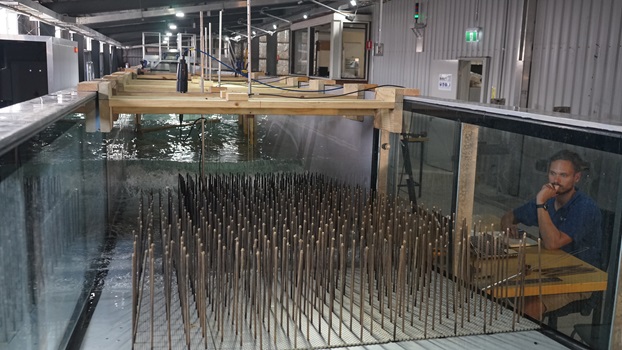
- ROV Launch through the splash zone
-
Ensuring the safety of ROV launch and recovery from a vessel to water is one of the first aspects of ROV deployment. When an ROV goes through the splash zone, the operator has to make sure that the tension in the line does not exceed its safe working load. However, the interaction between almost neutrally buoyant ROV and water is either cumbersome to analyse theoretically or is a demanding computational fluid dynamic process.
Therefore, we conducted an experiment in the wave flume using a scaled 1:10 model. Some phenomena, such as slamming (water entry), water exit, and high frequency snap of the cable are observed during the experiment, with the implication on safe working load investigated thoroughly. The result of the simulation tells how big the tension on line can exist which can be utilized for real life operation.
Key contact: Binsar Lubis
Email: [email protected]
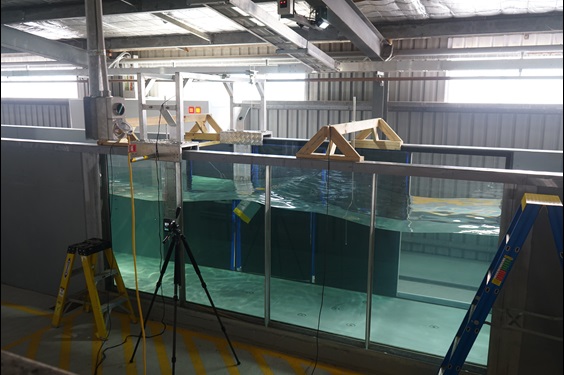
- Investigating effectiveness of a sponson to reduce greenwater
-
Greenwater can threaten the integrity of the deck by damaging structures, moving deck cargo or threatening the safety of personnel. Computational fluid dynamics and model scale testing are necessary to capture this complexity. Therefore, the COEL wave flume was used to investigate the impact of waves as they interact with a 1:100 scale model cross section of an FPSO.
The COEL wave flume is capable of replicating deepwater focused wave groups, an efficient means to explore the extreme response, avoiding the need to run long random simulations. The underlying spectrum for the wave groups were chosen to represent a realistic design sea state offshore the North West Shelf of Australia. Some phenomena such as overtopping, vertical jets of water and the interaction of multiple wave heights with varying freeboard exceedance ratios were observed.
Key contact: Scott Draper
Email: [email protected]
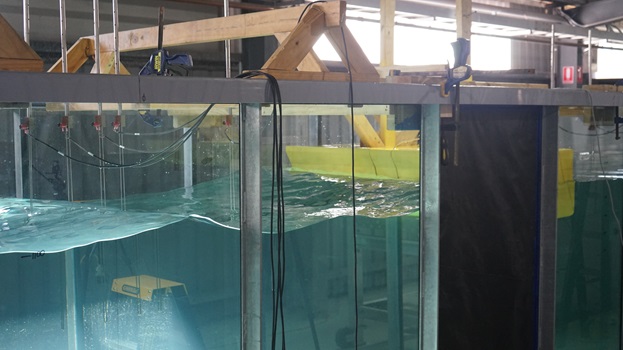
- Wave propagation over a shallowly submerged step
-
This work examines the propagation of waves, which are initially in deep water, over a shallowly submerged fixed step and into deep water again. The problem is of interest for many types of shallowly submerged structures including wave energy devices, sand bars and reefs. In this work we consider waves which are long compared to the step width and submergence.
When such long waves transition into shallow water, wave breaking and shallow water bores occur. Experiments in the COEL wave flume will improve our understanding of this complicated problem and provide data for validating numerical models.
Key contact: Guy McCauley
Email: [email protected]
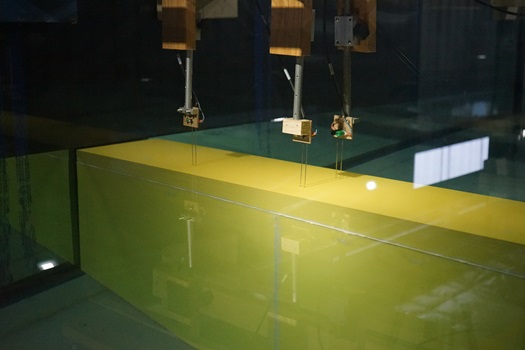
- Quantifying Wave Attenuation by Artificial Reefs
-
Natural reef structures (coral or rocky) protect vast portions of the world’s coastline from coastal flooding and erosion. Artificial reef structures can function similarly to protect coastlines by dissipating wave energy, while also delivering ecosystem services that can offer many additional benefits over conventional hard engineering structures. However, there is presently a lack of established guidelines to design artificial reefs for coastal protection. Therefore to better quantify the coastal protection afforded by Artificial reef structures, COEL undertook a physical model testing program in collaboration with Subcon. The aim of the testing was to better understand the capability of different arrangements of Artificial reefs to attenuate waves in different wave conditions and water depths.
Key contact: Justin Geldard
Email: [email protected]
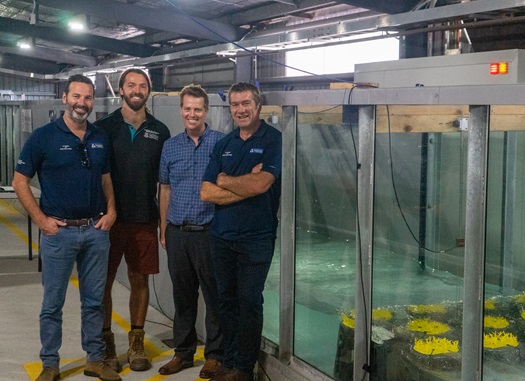
- Swimming in Surface Waves - Heave Frequency
-
Open water swimming is an endurance sport that is rising in popularity but presently lacks scientific understanding compared to its indoor counterpart. One difference with open water swimming is that swimmers will encounter surface waves, and will either have to swim with, or against the direction in which waves are propagating. For this study we investigated the effect of waves on the up and down motion (heave frequency) of swimmers. We conducted a total of 252 swim trials thanks to 14 volunteer swim participants, with each participant subject to a range of wave heights and wave periods.
Key contact: Grant Landers, Scott Draper
Email: [email protected], [email protected]
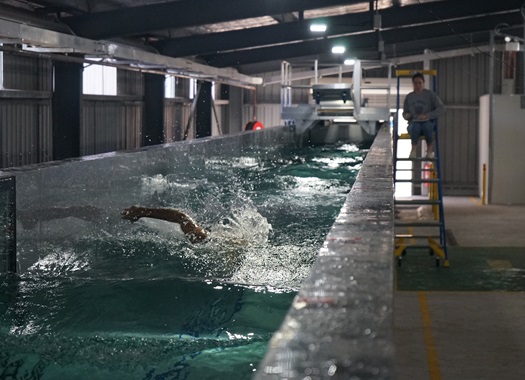
Current Projects
- Wave interaction with fixed and floating structures
- Loads on coastal and offshore structures
- Wave runup and overtopping
- Wave dynamics
- Wave breaking and surf/swash zone studies
- Eco-hydraulics studies
